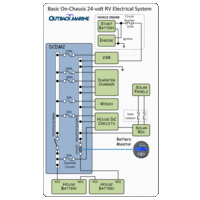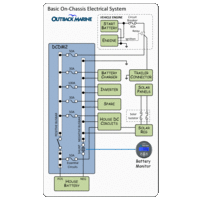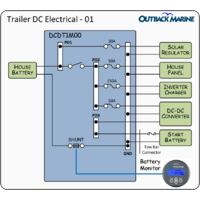
Victron 24-Volt VE.Bus Lithium Electrical System
This all Victron 24-volt on-chassis electrical system features Victron Smart Lithium batteries and associated equipment...
Read More
The three elements of caravan and RV electrical system implementation are electrical design, equipment selection and installation. Doing it right the first time might seem a touch expensive but the result, in the long run, is the most reliable and economical path.
Two everyday use cases drive the electrical system requirement. A conventional solution for caravan park stays is a 240-volt connection to the van and a 12-volt power supply for lights and DC appliances. The addition of a battery and solar panel is often a token gesture for camping away from the caravan park.
Free camping is a different story, and it is this use that we will examine here. A system design will consider energy storage (the battery), charging systems (vehicle engine, solar, mains power), loads (DC and 240-volt appliances) and power distribution (connecting things electrically). The vehicle use is also a consideration. For example, a setup that moves every day can rely on battery charging from an engine alternator as the primary energy source. However, if you have found a beautiful spot to stay for days at a time, then solar and maybe a small generator will be needed to keep up with the energy demand.
Caravan (trailer) and RV systems (on chassis) mainly differ in how the vehicle engine charges the house battery. An on-chassis system for an RV or 4WD can use a simple cross charge device that detects when the vehicle engine is running and connects the two batteries for charging. For trailers, the distance between the vehicle engine and the battery in the trailer causes an unreasonable voltage drop for simple cross charging. A particular DC-DC converter will be required to overcome the voltage loss and allow for correct battery charging. In both cases, right wire gauge is essential for proper and safe operation.
Purchasing equipment before having a design plan is non-sensical. The system design and equipment selection go hand in hand as the design will specify the equipment choice and how it fits together. It will also drive correct wire sizing and circuit protection.
The best design and equipment will not overcome poor installation practice. All equipment must be securely bolted down to endure the mechanical stress of mobile use. Wiring needs to be adequately secured and protected. Cable joints must be tight. Fuses and circuit breakers are there for a reason - to protect against fire if something unexpected happens.
The design examples below show a path to having an electrical system that can go the distance.
High reliability electrical systems for living away from the grid.

This all Victron 24-volt on-chassis electrical system features Victron Smart Lithium batteries and associated equipment...
Read More
An RV electrical system may not need a generator. With available battery capacity, an inverter-based system will provid...
Read More
This electrical system design is for an on-chassis electrical system that is typical for a 4WD canopy or smaller RV. In ...
Read More
This article describes the fundamental design elements of a caravan/trailer electrical system including a wiring diagram...
Read More